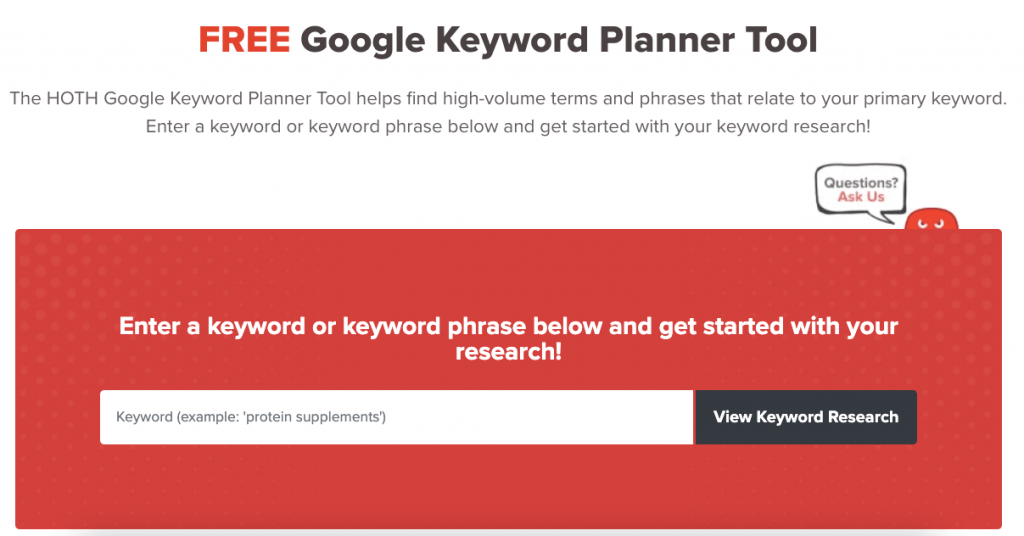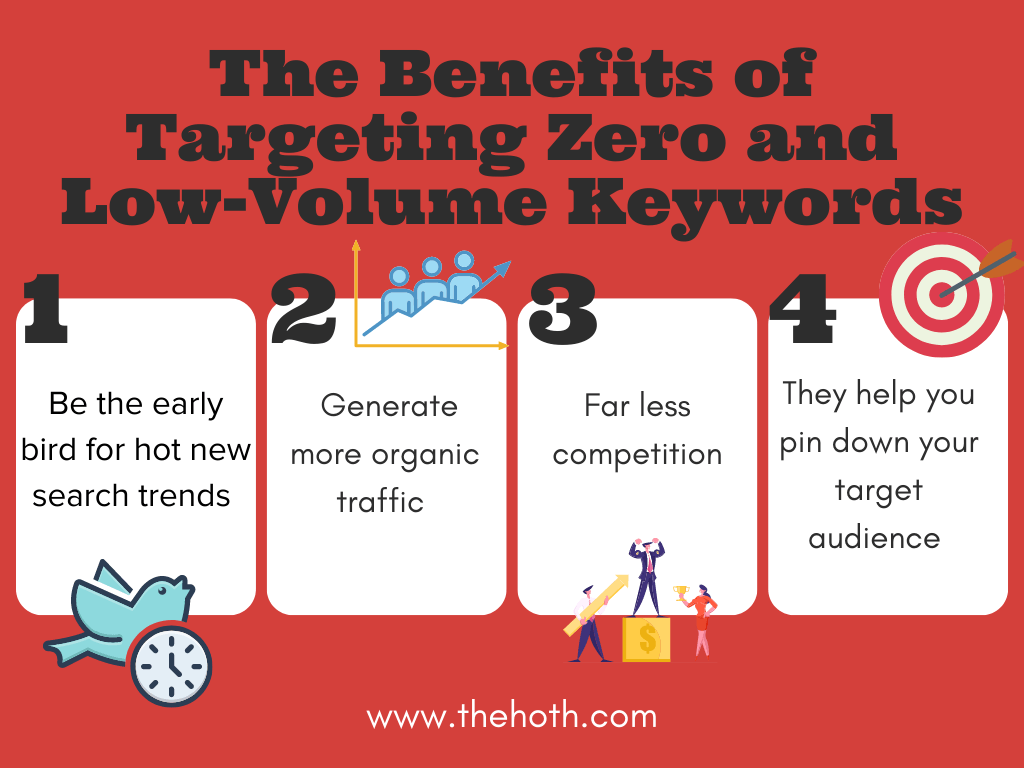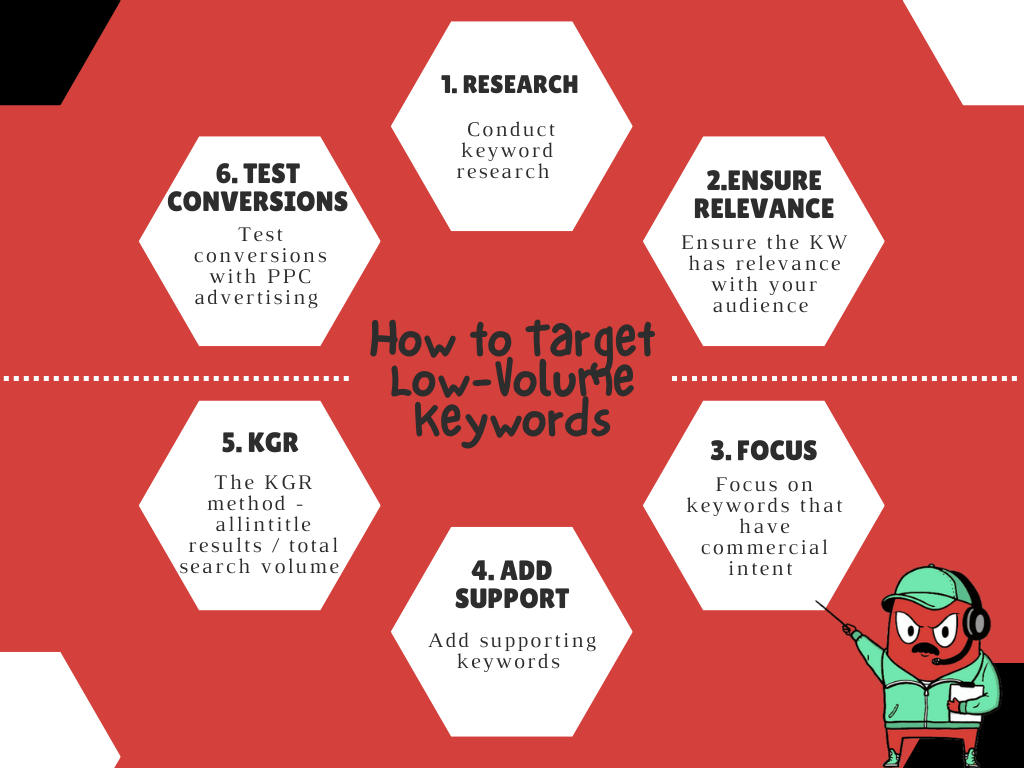
SEO 101 says that you should pursue keywords that have high search volumes, meaning that lots of users are searching for them online.
While this certainly isn’t wrong, it’s not always right 100% of the time, either.
For example, long-tail keywords (which tend to contain more than one word) are notorious for having low search volumes, but due to their highly specific nature, they’re still worth pursuing.
This is because long-tail keywords have stronger conversion rates (the average conversion rate for a long-tail keyword is 36%, while the best landing pages only convert at 11%).
But what about zero search volume keywords? There couldn’t possibly be a reason to pursue them, right?
Wrong!
It turns out that keywords with no search volume are actually extremely valuable if they have the right search intent.
Moreover, you can generate a TON of traffic without worrying about competitors getting in the way when you pursue zero search volume keywords.
In fact, 16 – 20% of ALL keywords on Google are brand-new, meaning that no one has searched for them yet.
This means that if you’re smart enough to create content for those keywords before they start receiving thousands of searches, you’ll already rank in the #1 spot!
The trick is knowing which keywords are about to blow up and which are truly worthy of their null search volume status.
In this article, we’re going to teach you how to uncover valuable zero search volume keywords.
You’ll also learn about long-tail keywords, the unreliability of keyword planner tool data, and how to use the Keyword Golden Ratio (KGR) technique – so stick around.
Understanding Zero Search Volume Keywords
Search volume is a keyword metric that displays how many users are currently searching for the query on search engines (most typically Google).
Essentially, a keyword’s search volume tells you how popular the keyword is at the moment.
As stated in the intro, the most popular SEO strategy is to target keywords that have high search volumes.
This ensures the content you create for the keywords has a sizable audience, increasing the chances of boosting your organic traffic.
Long-tail keywords are the exception to this rule, as these types of keywords don’t receive much search volume.
| What determines a keyword’s tail? SEOs refer to keywords as having short-tails or long-tails due to their position on the search demand curve.
Short-tail keywords (also called head keywords) are industry terms that only contain a few words but receive millions of searches per month. Long-tail keywords receive far fewer searches, but they account for a vast majority of the keywords searched for online. |
Offsetting the low search volume is how highly targeted long-tail keywords are, which contributes to their strong conversion rates.
Still, a long-tail keyword is bound to have 50 or maybe 100 searches per month.
What about keywords that truly have zero search volume?
We’re talking nil, nada, zilch in the way of search volume, at least according to keyword planner tools.
It could be that the research tools have yet to update their data, or the keyword could be brand-new and truly have zero search volume.
Either way, these types of keywords require a special approach for them to bear fruit.
Finding a zero search volume keyword
Let’s use our free keyword planner tool to hunt down a zero search volume keyword so you can see what we’re talking about.
steep.

First, let’s search for an example of a short-tail keyword that has a high search volume. An industry keyword like ‘organic traffic’ should do the trick:

As you can see, it has a search volume of 1,600, which is quite high, and a keyword difficulty score of 69, which is pretty steep.
A keyword’s difficulty score refers to how difficult it will be to rank #1 for it, given the amount of competition.
One of the major benefits of long-tail and zero search volume keywords is their low keyword difficulty scores.
Now, let’s add some more words to our keyword to see if we can trigger a zero search volume keyword. Here’s what happens when we search for the keyword ‘SEO for organic traffic’ using our tool:

As you can see, the keyword and its related keywords are all registering 0s across the board. Not only is the search volume 0 but so is the keyword difficulty score.
If you were to take these numbers at face value, there’d be no benefit in targeting the keyword ‘SEO for organic traffic’ since nobody is searching for it.
But is this really the case?
Let’s find out.
Zero Search Volume and Long-Tail Keywords: What’s the Difference?
First, let’s briefly distinguish the difference between zero search volume and long-tail keywords, as it can quickly get confusing.
Here’s the main difference between the two:
Long-tail keywords have some measurable search volume, even if it’s small.
Zero search volume keywords show no search volume in keyword tools.
Where things get a tad complicated is that every zero search volume keyword is also a long-tail keyword.
This is because even though these keywords have zero search volume, they still appear on the long-tail of the search demand curve.
Therefore, if you ever hear an SEO referring to a zero search volume keyword as a long-tail keyword, they aren’t wrong!
Also, users can phrase long-tail keywords in various ways. For example, with the keyword “SEO for organic traffic,” users might also search for:
- How to do SEO for organic traffic
- Organic traffic for SEO
- Using SEO to generate organic traffic
These variations all share the same search intent and count as phrase matches (closely related keywords that contain the same phrase in different ways) for the original keyword ‘SEO for organic traffic.’
Why does this matter for zero search volume keywords?
While a single keyword may show no search volume, the combined search volume of related keywords can be substantial. This is because search engines recognize the shared intent behind different phrasings of the same query.
Speaking of which..
| Sneaky zero search volume keywords fact: Just because a keyword has zero search volume doesn’t mean its related keywords do, too. This means it’s possible to generate quite a bit of traffic off phrase match keywords alone. |
Here are a few more ways zero search volume keywords are sneaky little devils:
- Aggregated value: Individually, these keywords might appear insignificant on keyword planner tools. However, together, they can drive significant traffic to your website.
- Search intent alignment: The best way to determine if a zero search volume keyword is worth pursuing is by understanding its search intent. If you optimize your content for a relevant user query variation, such as “how to do SEO for organic traffic,” your website will likely appear in search results for all related searches.
- Google’s algorithm: Google’s algorithms are advanced enough to recognize when different phrases have the same intent. This means your webpage can show up in search results for all variations of a keyword as long as they have identical search intent.
To summarize, zero search volume keywords are valuable when you understand and leverage their search intent. By optimizing for one variation of a pertinent user question, you can capture traffic from all related searches, in turn maximizing your reach and effectiveness.
| Key point: What is search intent?
Search intent refers to the purpose behind a user’s query in a search engine. It reflects what the user is looking for and why they are conducting the search. Understanding search intent is how you create content that meets your target audience’s needs and expectations, ensuring higher relevance and satisfaction. There are three main types of search intent: ➡️Informational intent: The user is looking for information or answers to specific questions (e.g., “how to bake a cake” or “what is climate change”). ➡️Navigational intent: The user wants to find a specific website or webpage (e.g., “Facebook login” or “CNN news”). ➡️Transactional intent: The user intends to complete a transaction, such as making a purchase (e.g., “buy samsung galaxy phone” or “best deals on laptops”). |
Keyword Planner Tools Are a Guide, Not a Crystal Ball
Most SEO advice emphasizes targeting high-volume, low-competition keywords.
Keyword planner tools are essential for finding these opportunities, but it’s important to understand their limitations:
ℹ️Search volume data isn’t always accurate. Different tools can show very different search volumes for the same keyword. This is because they rely on estimates, not exact figures.
ℹ️Low-volume keywords might be underestimated. Many tools have a threshold for how much data a keyword needs to register. This means low-volume keywords, especially those with informational intent, can be overlooked.
Why the discrepancies?
Most tools get their data from Google Keyword Planner, which primarily focuses on commercial keywords and doesn’t cover all search types.
Also, the sheer volume of Google searches (8.5 billion every day) makes it impossible for any tool to track everything with 100% accuracy. Plus, some keywords might not have enough data to register in a tool’s database to begin with (due to them being brand-new).
Lastly, Google Keyword Planner groups keywords into “buckets” of estimated search volume. This means the number you see is often just an approximation.
| Key point: What is a “search bucket”?
Think of “traffic buckets” as giant containers for search volume. Instead of showing exact numbers, keyword tools estimate a keyword’s search volume and put it into the closest bucket (e.g., 100-500 searches, 501-1,000 searches, etc.). So, the number you see might not be the exact number of searches, but it gives you a general idea of the keyword’s popularity within that range. |
This means you shouldn’t take search volume numbers at face value when it comes to your keyword research.
Use them as a guide, not a definitive answer.
All this should show you that it’s beneficial to look beyond high-volume keywords, especially if you’re in a fiercely competitive niche.
That’s why you need to consider low-volume and zero-search volume keywords, especially if they align with your target audience’s needs.
The Benefits of Targeting Zero and Low-Volume Keywords
You may be wondering, “What’s in it for me? Is there really enough benefit in targeting zero search volume keywords? Will it deter me from my already successful SEO strategy of targeting high-volume keywords?”
The answer is no, it won’t – and you stand to gain quite a bit from zero search keyword phrases if you do it right.
With the perfect zero search volume keyword, you’ll be able to operate in a space with virtually no competitors, which is an incredible advantage. That dramatically increases your chances of ranking on the first page of search engine results pages, and who’s not a fan of that?
Higher rankings aren’t the only perks of targeting keywords with no search volume, either, so let’s look at some of the most appealing benefits.

#1: Be the early bird for *** new search trends
Whenever a trend takes off, established websites (think Forbes, The New York Times, and Reddit) sweep in and take over.
At this point, it’s incredibly difficult to outrank major websites for short-tail keywords related to trends.
Since behemoths like Forbes have Domain Rating scores in the 90s, they’re always going to outrank smaller sites – especially in the top 5 organic results.
However, if you’re savvy about monitoring social trends and news sites, you can get ahead by targeting emerging keywords before they become trendy.
So, while these keywords may have zero search volume at the moment, they’re about to blow up in a big way.
Here’s how you can spot potentially trending keywords in your field:
➡️ Know your niche: Stay up-to-**** on industry news (big and small) and try to predict what users might start searching for.
For instance, if a company is about to launch a new software product in your industry, it’s likely your target audience will search for tutorials and ways to use it. These detailed, long-tail keywords (i.e., ‘how to use (new software product)’) likely won’t have any search volume yet, but you’ll know that’s about to change.
➡️ Use social media: Monitor trending hashtags on X and Instagram to identify potential search terms. Also, consider relevant communities on Reddit.
➡️ Search for emerging trends: Use Google Trends or Exploding Topics to see if a keyword is gaining popularity and track its progress over time.
If you have the budget, a social listening tool like Hootsuite is a wise investment.
That’s because you can configure it to automatically track relevant:
- Hashtags
- Topics
- Social conversations
- Trends
You can set up notifications so that you’ll know precisely when crucial trend-forming conversations take place. This helps you spot trends extremely early, which is great for honing in on zero search volume keywords.
How to use Google Trends
The benefit of using Google Trends is that it’s completely free.
Here’s how to use it.

1. Access Google Trends:
Go to the Google Trends website.
2. Enter Your Search Term or Topic:
Type a keyword, phrase, or topic into the search bar and press enter.

3. Analyze the Results:
After you hit the Explore button, Google Trends will present you with a few sections of data:
- Interest Over Time: A graph showing the search term’s popularity over a selected time period (you can adjust the time frame).

- Interest by Region: A map showcasing the search term’s popularity in different geographic locations.

- Related Topics: Other topics related to your search term are also trending.
- Related Queries: Specific search queries related to your term that are also popular.

As you can see, Google Trends equips you with plenty of data to spot keywords that are rising in popularity. In particular, look for keywords that are starting to trend up on the Interest Over Time line graph.
| Pro tip: Use the “Related Queries” section to discover other keywords that people are searching for alongside your main term. |
#2: Generate more organic traffic
Even if your website is thriving with high-volume keywords, there’s always untapped potential in long-tail keywords, even those with seemingly zero search volume.

Why?
As mentioned above, 16-20% of daily Google searches are entirely new. That’s a significant portion of potential traffic that you shouldn’t overlook.
Most businesses focus solely on popular short-tail keywords, leaving the vast majority of long-tail searches (70%) wide open for you to capture.
With 56% of buyers preferring search phrases of three or more words, long-tail keywords offer a powerful way to reach a highly targeted audience actively seeking solutions, which results in higher conversion rates.
So, by targeting these longer queries, you’re tapping into a largely untapped **** of potential customers who have shown interest in what you do.
#3: Far less competition
Too much competition has been the undoing of many an SEO strategy.
Even with outstanding original content and flawless technical SEO, you can be outranked by:
- Competitors with more authoritative backlinks
- Optimized local business listings
- Established pages with long-standing rankings
Also, PPC ads, the new AI Overview, and SERP features like snippets, knowledge panels, and image carousels can outrank your content.
Targeting zero search volume keywords offers a solution to this frustrating issue.
These keywords have minimal competition, allowing your content to become an authority on the subject. Google and other search engines will prioritize your content during indexing, increasing your chances of ranking highly.
As competitors eventually target these topics, your well-established content will already hold the top spots, making it difficult for others to dethrone you.
| Pro-tip: Optimize for SERP features like featured snippets and knowledge panels to enhance your visibility. Doing so lets you secure position zero, which is an extremely powerful position to hold on the SERPs. |
#4: They help you pin down your target audience
Another benefit of long-tail zero search volume keywords is that they’re highly specific, which means they’re highly relevant to your audience.
There’s often a lack of content addressing these queries, so your content can be the very first of its kind!
For example, consider the keyword “increase SEO for SaaS companies.” Despite its zero search volume on Ahrefs, many SaaS digital marketing managers are likely searching for this term or similar phrases. Most current content focuses on the broader term “SEO for SaaS.”
By creating content optimized for the long-tail keyword, you can attract these marketers.
Your specific, in-depth content will better meet their needs than generalized articles. This can lead to more traffic and insights into your audience’s preferences and search behavior.
How to Target Low-Volume Keywords
Now that you know that targeting zero search volume keywords is more than worth it, you need to learn how to discover and target them.
After all, just because a keyword has no search volume doesn’t automatically make it an untapped goldmine.
Plenty of low-volume keywords live up to their reputation – and if you target them in your content, you likely won’t see any results at all.
Does that mean zero search volume keywords are one giant gamble?
Not at all, as there are plenty of ways to discover if a low-volume keyword is worth your time and money or not. So, before you go targeting every long-tail keyword you can find that relates to your niche, stop and read this section first.
As a rule of thumb, before you target a keyword, you should take the following steps:
- Conduct detailed keyword research
- Ensure its relevance with your audience
- Focus on keywords that have commercial intent
- Add strong supporting keywords (LSI)
- Try the KGR method (keyword golden ratio)
- Test your conversion rates and tweak accordingly
It’s important to follow these series of steps before pulling the trigger on a zero search volume keyword, so let’s take a more in-depth look at each one.

Step #1: Conduct keyword research
The keyword research you’ll need to conduct for zero search volume keywords differs a bit from the traditional route.
Instead of relying on keyword planner tools, you’ll want to search for specific long-tail keywords on Google.
To see this in action, let’s try it out with the short-tail keyword ‘SEO for SaaS.’
We entered the term into Google. Here’s the long-tail keywords that came up under the People Also Ask section:

As you can see, these are all excellent long-tail keywords (that likely have low search volume) that you can target for content.
Sure enough, if we run one of the phrases through our keyword planner tool, we can see that it returns no results or phrase matches, which means it definitely has no search volume:

Use Google Autocomplete
Another secret ****** you can use is Google Autocomplete. You’ll see it in action the second you type a single letter into the search bar.
Google immediately starts recommending keywords that it thinks you want to search for to speed things up.
Here’s a quick overview of how it works:
- You start typing in a search query.
- Google’s algorithms analyze and compare your input to vast amounts of data.
- Predictions appear in a dropdown menu below the search bar.
- You can click a prediction to complete your search or continue typing to refine your query.
This is huge because these aren’t random suggestions; they’re real keywords that users search for – so they’re all valid keywords you can use.
To make this feature even more effective, get the Keyword Surfer add-on for Google Chrome.
That way, you’ll see each keyword’s search volume next to it in the autocomplete section. This is EXTREMELY useful if you plan on implementing this strategy, so don’t pass it up.
Step #2: Ensure the keyword is relevant to your audience
Targeting zero-search keywords requires a bit of detective work.
Since these keywords lack search data, you’ll need to assess their relevance to your target audience through other means. Here’s how:
Tap into community conversations: Explore platforms like X, Reddit, forums, and Facebook groups where your audience gathers online. Look for discussions and mentions of your potential keywords. Frequent mentions can indicate growing interest and potential search volume, so keep your eyes open.
Leverage social listening tools: Tools like Moz and Semrush can help you track keyword mentions across social media. Remember to filter out brand names for a more accurate picture.
Step #3: Focus on keywords that have commercial intent
If you want to boost your sales and enjoy higher conversion rates (which, who doesn’t?), focus on zero-search volume keywords with strong commercial intent.
In other words, whenever a keyword has commercial intent, it means the prospect has their wallet in their hand, and they’re ready to buy something.
Commercial intent keywords often contain the following phrases:
- Vs. (or comparison)
- Best
- Top
- Suppliers
- Discount
- Coupon
- Deal
- Providers
- Get
- Where to buy
All these phrases represent an intent to buy, so you should pepper them into your long-tail queries whenever possible.
Why is it beneficial to focus on these types of keywords?
Prioritizing commercial and transactional keywords allows you to capture high-intent users who are ready to buy, directly impacting your bottom line.
While informational keywords can be useful for building brand awareness, they are less likely to generate immediate sales, so you shouldn’t focus on them too much if your primary goal is to increase your revenue.
Step #4: Add supporting keywords
Next, adding latent semantic indexing (LSI) keywords to your primary keyword is a good idea.
| Pro-tip: What are latent semantic indexing keywords (LSI)?
LSI keywords are supporting keywords that directly relate to your target keyword. Adding these keywords can help you rank for additional, related keywords – often called ‘low-hanging fruit.’ As an example, if your primary keyword is ‘cat,’ then LSI keywords would include terms like ‘tabby,’ ‘litter,’ ‘burmese,’ and other cat-related terms. |
Yet, the accumulation of traffic from these additional keywords can be quite profound.
These keywords often take the form of questions (such as the queries found in the People Also Ask section of Google).
As such, answering these questions in your content will increase your chances of gaining additional search engine real estate for those queries.
An example would be snagging a featured snippet, which is a powerful SERP feature that typically provides answers to questions:

Step #5: The KGR method
The Keyword Golden Ratio is a formula developed by Doug Cunnington that helps identify keywords with low competition and decent search volume.
The goal is to find keywords that are easy to rank for and can drive targeted traffic to your site.
The KGR formula is:
KGR= Monthly search volume / Number of Google results that have the keyword phrase in the title
To break it down:
➡️ Allintitle search: Use the “allintitle:” search operator in Google to find the number of pages with the exact keyword phrase in their title.
➡️ Monthly search volume: Find the monthly search volume for the keyword using tools like Ahrefs, SEMrush, or Google Keyword Planner.
Ideal KGR values:
<0.25: Golden opportunity! These keywords are ripe for ranking quickly.
Between 0.25 and 1: Moderate competition. Ranking is possible, but it might take longer.
<1: Highly competitive. Avoid these, especially if your website is new.
Here’s an example to illustrate our point:
A keyword with 50 “allintitle” results and 200 monthly searches would have a KGR of 0.25, making it a prime target for quick ranking.
Using this formula, you can predict (with surprising accuracy) where you’ll rank in the SERPs and how long it will take!
Concluding Thoughts: Zero Search Volume Keywords
If your SEO efforts have hit a snag, it could be that you’re targeting keywords with too much competition.
After all, everyone and their brother goes after short-tail keywords, so be a trendsetter and do the opposite.
With the proper research and preparation, zero search volume keywords can generate loads of traffic and conversions for you.
Remember to do thorough research, focus on commercial intent keywords, and use the KGR method wherever possible.
Do you lack the manpower or resources at your company to launch an SEO strategy?
Then, you’re a perfect candidate for HOTH X, our fully managed SEO service. Our team will simplify your SEO success, so don’t wait to get in touch for a free consultation!



